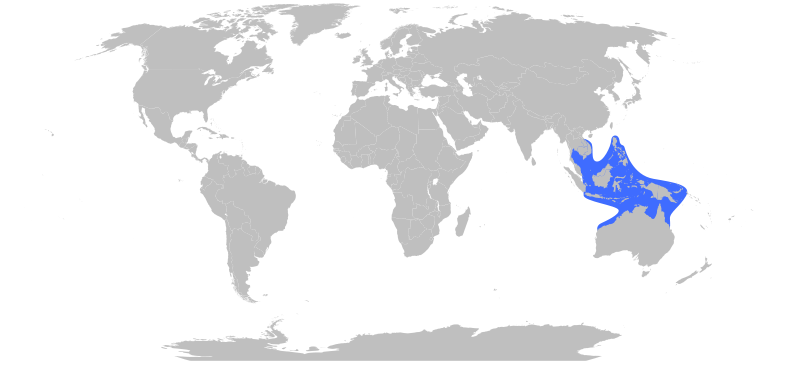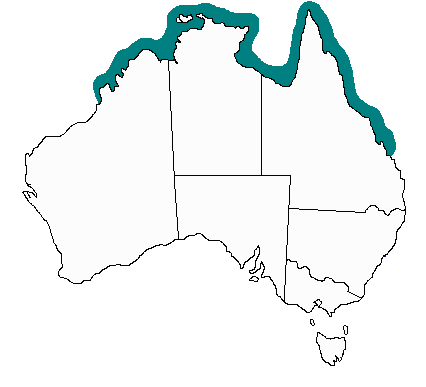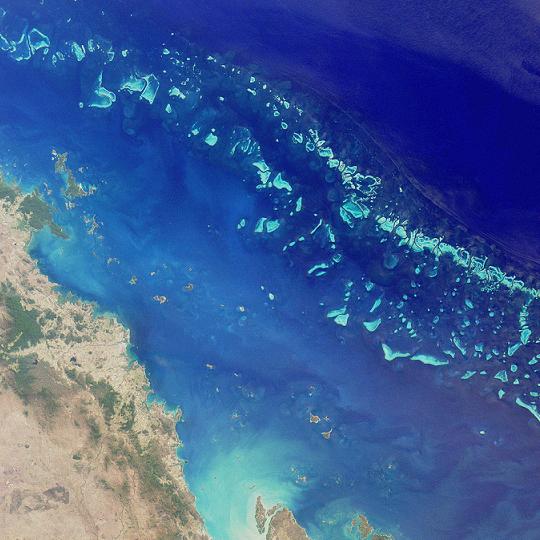Habitat
Chironex fleckeri organisms inhabit many tourist
areas in the eastern hemisphere. They can cause extensive
problems during the summer months in the Australian tropics.
These jellyfish are a major threat to civilians who partake in
swimming excursions, other recreational activities, and
commercial events near their habitat. You can find this species
swimming near the northern coast of Australia and all the way up
to southeast Asia. They are considered to be native species to
Australia, the Indian Ocean, and the Pacific Ocean. 'Native
species' means
that this jellyfish has lived in this environment since it first
evolved and has been adapting to the changing conditions as the
years have passed. It has also remained in these specific areas
located on the maps shown. Susan Jacups of Charles Darwin
University, 2010, has used statistical analysis to study the
arrival of C. fleckeri in the Northern Territory of
Australia waters. Her findings have shown that this species
returns to these waters after their mating season when the Sea
Surface Temperature (SST) reaches 26°
Celsius (C). However, more research has shown that many stings
occur in water that is at least over 27° C,
with the average water temperature being near 30° C. This data
demonstrates the importance of this knowledge in regards to
protecting the communities around this jelly's habitat along
with taking precautions that can save lives.
are considered to be native species to
Australia, the Indian Ocean, and the Pacific Ocean. 'Native
species' means
that this jellyfish has lived in this environment since it first
evolved and has been adapting to the changing conditions as the
years have passed. It has also remained in these specific areas
located on the maps shown. Susan Jacups of Charles Darwin
University, 2010, has used statistical analysis to study the
arrival of C. fleckeri in the Northern Territory of
Australia waters. Her findings have shown that this species
returns to these waters after their mating season when the Sea
Surface Temperature (SST) reaches 26°
Celsius (C). However, more research has shown that many stings
occur in water that is at least over 27° C,
with the average water temperature being near 30° C. This data
demonstrates the importance of this knowledge in regards to
protecting the communities around this jelly's habitat along
with taking precautions that can save lives.
 Chironex
fleckeri also inhabits shallow, gloomy waters.
Areas such as these are where trouble may emerge. The
box jelly's nearly transparent body becomes even more
unnoticeable when placed in this environment. This
mechanism is one in which the jellyfish benefits, but
human recreationists can encounter a major dilemma.
Along with these areas, this species also inhabits
freshwater rivers during its reproductive season. To
learn more about this, visit the
Reproduction page!
Chironex
fleckeri also inhabits shallow, gloomy waters.
Areas such as these are where trouble may emerge. The
box jelly's nearly transparent body becomes even more
unnoticeable when placed in this environment. This
mechanism is one in which the jellyfish benefits, but
human recreationists can encounter a major dilemma.
Along with these areas, this species also inhabits
freshwater rivers during its reproductive season. To
learn more about this, visit the
Reproduction page!
One major problem regarding this box jelly's habitat is that people are constantly around them. With this species found in and around the Great Barrier Reef, safety precautions must be taken very seriously in these regions to avoid being stung by this deadly creature. Surfers and divers in particular can wear certain wet suits that protect themselves against this box jellyfish's deadly sting. If these precautions are not taken seriously, injuries (and sometimes death) can occur. To learn more about getting stung by this jellyfish, visit the Facts or Interactions pages! Want to learn about another species that lives near the Great Barrier Reef? Check out this organism: Thenus orientalis!
Want to learn of another animals that live near these regions? Check out the webpages all about Stichopus chloronotus, commonly known as the Greenfish, or Hippocampus kelloggi, the Great Seahorse!
Continue reading all about Chironex fleckeri by visiting the Adaptations page.
Are you lost? Start all over at the Home page!

